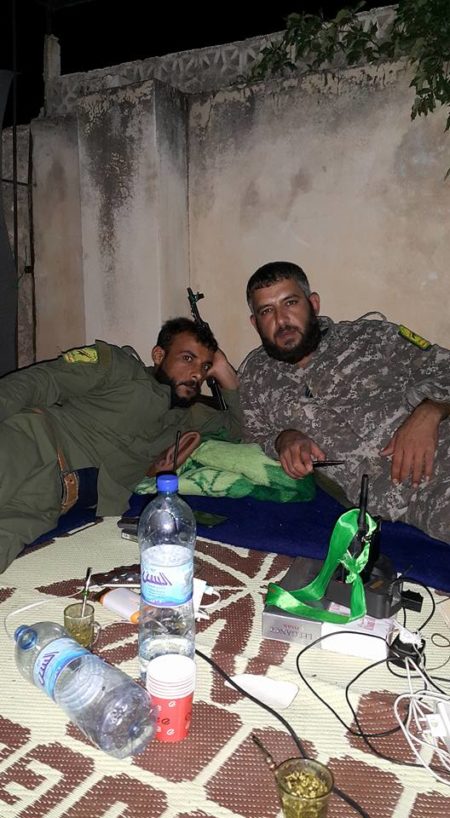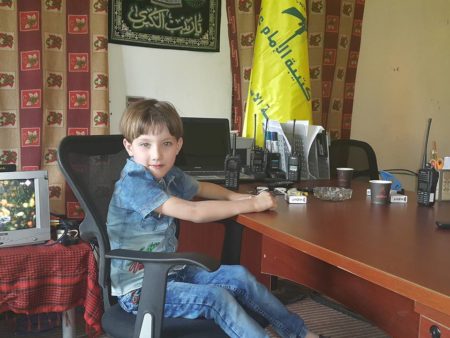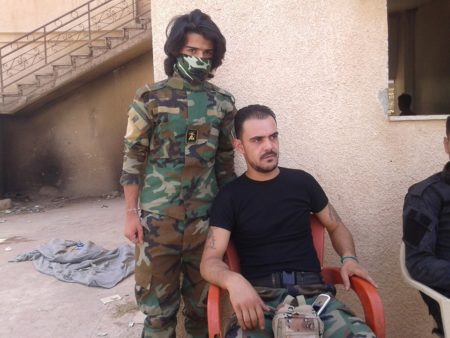Quwat Dir’ Al-Amn Al-Askari: A Latakia Military Intelligence Militia
Posted by Aymenn Al-Tamimi on Saturday, September 3rd, 2016
By Aymenn Jawad Al-Tamimi

Emblem of Quwat Dir’ al-Amn al-Askari as it appears on insignia.
The previous article discussed Fawj Maghawir al-Badiya, a militia affiliated with the Military Intelligence Branch (Shu’abat al-Mukharabat al-Askariya). This piece looks at another militia affiliated with regime intelligence: Quwat Dir’ al-Amn al-Askari (“The Military Security Shield Forces”). As the group’s name suggests, it is affiliated with al-Amn al-Askari (“The Military Security”), but it should be noted that there is no real difference between the Military Intelligence Branch and the Military Security. In the present day, the two names just refer to military intelligence affiliated with the Ministry of Defence, but at the provincial level the brand and nae of al-Amn al-Askari seem to be more recognisable. In the case of Quwat Dir’ al-Amn al-Askari, it appears that we can identify a more geographically specific affiliation: that is, branch 223 of the Military Security based in Latakia province. This branch has been identified before in the militiafication phenomenon for its involvement in the provision of arms and arm-bearing ID cards to members of the Popular Committees in Latakia province.
Quwat Dir’ al-Amn al-Askari first emerges as a military force around January 2016. This approximately correlates with the testimony of a source from Mihrac Ural’s al-Muqawama al-Suriya (“The Syrian Resistance”), which works closely with Quwat Dir’ al-Amn al-Askari in the ongoing fighting in Aleppo. The source, in a conversation in late July 2016, mentioned at the time that the group had been set up “several months ago.” The group’s pages on Facebook feature multiple phone numbers that one can connect with: the purpose of putting up these numbers is clearly recruitment. Indeed, this purpose was made apparent in one post put up by a page for the militia in mid-March 2016:
“Announcement: the door of recruitment within Quwat Dir’ al-Amn al-Askari is open for all sons of our beloved land. Your land is calling you: heed the call. To connect with us: 0933055137.”
Considering its specific affiliation, Quwat Dir’ al-Amn al-Askari’s first major engagement was unsurprisingly in north Latakia province in the January-February period as part of a Russian-backed offensive bolstered by multiple militias, including Suqur al-Sahara’, Liwa Usud al-Hussein and the Iraqi Shi’i Liwa Assad Allah al-Ghalib. Though this offensive gained significant ground against the rebels, it ultimately failed to expel them entirely from the province. Even so, the head of branch 223 of the Military Security based in Latakia province received an award from the Russian and Syrian commands on account of his supposed role in the operations and presence on the battlefield while rejecting media appearances.

Quwat Dir’ al-Amn al-Askari fighter in Kanasba, Latakia, posing outside what appears to be a Harakat Sham al-Islam base. Photo from February 2016.
It was also around this time that the militia advertised the bolstering of its ranks with new recruits:

“A new group from Quwat Dir’ al-Amn al-Askari. Success oh Lord.”
The next major campaign involved deployments from Latakia to the deserts east of Homs in order to participate the recapture of Palmyra from the Islamic State in March 2016. These operations featured recognisable appearances from a commander in Quwat Dir’ al-Amn al-Askari: a man going by the name of al-Khal Abu Ismail (al-Khal translating as “The Uncle”). There was also some display of brutality in featuring at least one photo with a severed head.


In the centre: al-Khal Abu Ismail.
The figure of al-Khal Abu Ismail is of particular interest. A biography of him notes that he is originally from Assad’s ancestral village of al-Qardaha in Latakia province, and that he was a companion of Ali Khazzam, who was a renowned commander in the Republican Guard killed in October 2012 (thus he is known by the title Amir al-Shuhada’: Prince of Martyrs). The biography also notes that he has fought in battles in Aleppo, Latakia countryside, Idlib, Hama, Damascus and Deraa. The biography adds that he has “fighting contingents in Aleppo, Latakia, Deraa, Damascus and Homs.”

al-Khal Abu Ismail. Note his armpatch: “The Republican Guard: The Martyr Ali Khazzam Battalion.”
Quwat Dir’ al-Amn al-Askari contingents continued to remain deployed in the Palmyra area through the rest of the spring and into the summer. In June 2016, some fighters participated in a regime offensive against the Islamic State launched from Athiriya Raqqa province that aimed to push towards the Tabqa area, backed by other militias like Suqur al-Sahara’, Fawj Maghawir al-Bahr and the Syrian Social Nationalist Party’s Nusur al-Zawba’a. This offensive ultimately failed, as the Islamic State launched a counter-attack and routed the regime forces and its allies from the province.
July 2016 saw reports of fighting on the part of Quwat Dir’ al-Amn al-Askari contingents in Latakia and the Aleppo city area. The former, which is ongoing, began with a rebel offensive that seized the locality of Kanasba by the start of July 2016. The Aleppo fighting, which also continues to this day, is part of the regime’s initiative to try to encircle the rebel-held eastern part of the city and impose a siege, currently undermined by a Jaysh al-Fath-led counter-offensive that opened up a new corridor to eastern Aleppo via Ramouseh in the southwest of the city. The first phase of the operations involved fighting on the northern fronts of the city, including al-Melah, Bani Zaid and the Castello road. As mentioned previously, these operations have entailed close cooperation with the Syrian Resistance. As part of this phase, the Syrian Resistance affirmed at the end of July 2016 that it had sent up reinforcement contingents from Hama to reinforce the Castello road front, where cooperation was occurring alongside the Quwat Dir’ al-Amn al-Askari. A Quwat Dir’ al-Amn al-Askari Aleppo contingent leader presented in these accounts is one Mudar Makhlouf, who has long been known for his Military Security affiliation and appears to be most distinguished for leading Military Security militia contingents in Deir az-Zor, for which reason a fan page dedicated to him refers to him as Azra’il al-Dawa’ish (“The Angel of Death for the Da’ish people”) in reference to fighting between regime forces and the Islamic State.

A photo featuring Mudar Makhlouf (left) and Issam Zahr al-Din (right), a Druze commander in the Republican Guard deployed to Deir az-Zor.
As the Jaysh al-Fath counter-offensive made gains against the regime to the southwest of Aleppo city in early August, one of the Quwat Dir’ al-Amn al-Askari pages claimed that the group had sent 400 fighters to assist the Syrian army on the military colleges front in that area, though that initiative did not prevent the breaking of the siege. The militia has continued to claim involvement on the southwest Aleppo front particularly in the area of those military colleges, but the corridor opened by the rebels has not yet been fully closed. These operations, as in the earlier phase on the northern front, are being coordinated with the Syrian Resistance. Another force coordinating with Quwat Dir’ al-Amn al-Askari on this front is one known by the Arabic acronym Qadish, which stands for Quwat al-Amn wa al-Da’am al-Sha’abi (“Popular Security and Support Forces”) . These forces serve as auxiliary militias affiliated with the Republican Guard.
For its efforts on the Aleppo front, the head of the 223 branch of Military Security has notably paid special tribute to Quwat Dir’ al-Amn al-Askari, further pointing to links between the two.
Finally, in terms of operations, it should be noted that a contingent of Quwat Dir’ al-Amn al-Askari under the field commander Hassan Mahfoudh (otherwise obscure) is reported to be deployed most recently to Hama province as part of countering the Marwan Hadid offensive in north Hama countryside led mainly by Jund al-Aqsa, Abna’ al-Sham and Jaysh al-Nasr.

A Quwat Dir’ al-Amn al-Askari fighter posing outside what appears to be a base for a rebel group in Latakia: Katibat Ahfad Omar. Photo from a personal account.
It can be seen from the overview of Quwat Dir’ al-Amn al-Askari that the military intelligence’s involvement in organizing militia efforts is not exactly a new phenomenon. This is foremost apparent in Mudar Makhlouf’s prior efforts in Deir az-Zor, as well as the military security Latakia branch’s prior interactions with the Popular Committees. That said, it appears the formation of Quwat Dir’ al-Amn al-Askari as a distinct formation and brand represents an attempt by the military intelligence branch in Latakia to build its influence, while fitting into the wider trend of compensating for manpower shortages on the regime side exacerbated by draft evasion.




































 The Syrian coalition and military commanders, such as Colonel Abdul Jabaar al-Aqidi, were the principal allies of the west. Pictures of the Colonel standing with foreign jihadists who belonged to the Islamic State during the capture of Kuweiris air base and subsequently standing with Ambassador Robert Ford became iconic of Washington’s confused strategy in Syria. Many accused Washington of indirectly supporting the same jihadists that it sought to destroy. This doomed policy was a result of conflicting goals. The West and its regional allies wanted stability and regime-change at the same time. They wanted to support a Sunni ascendancy in Syria without undermining secularism. On the ground, however, the extreme right side of the opposition spectrum kept moving left and swallowing all others in its path. To date, the main elements of the opposition blame President Obama for the Syrian crisis. They propose a variety of policy alternatives, such as bombing Damascus, destroying the Syrian air force, establishing no-fly-zones, and increasing money, arms, and training for the opposition. These critics are now placing their bets on Hillary Clinton, who promises to be more hawkish than Obama. They hope that she will tilt U.S. foreign policy more decisively in the direction of regime-change. Her campaign advisors suggest that Hillary may indeed move in this direction. But any escalation by Washington is only likely to produce an even stronger escalation by Moscow. Hillary’s campaign promises are likely to be moderated once she is president.
The Syrian coalition and military commanders, such as Colonel Abdul Jabaar al-Aqidi, were the principal allies of the west. Pictures of the Colonel standing with foreign jihadists who belonged to the Islamic State during the capture of Kuweiris air base and subsequently standing with Ambassador Robert Ford became iconic of Washington’s confused strategy in Syria. Many accused Washington of indirectly supporting the same jihadists that it sought to destroy. This doomed policy was a result of conflicting goals. The West and its regional allies wanted stability and regime-change at the same time. They wanted to support a Sunni ascendancy in Syria without undermining secularism. On the ground, however, the extreme right side of the opposition spectrum kept moving left and swallowing all others in its path. To date, the main elements of the opposition blame President Obama for the Syrian crisis. They propose a variety of policy alternatives, such as bombing Damascus, destroying the Syrian air force, establishing no-fly-zones, and increasing money, arms, and training for the opposition. These critics are now placing their bets on Hillary Clinton, who promises to be more hawkish than Obama. They hope that she will tilt U.S. foreign policy more decisively in the direction of regime-change. Her campaign advisors suggest that Hillary may indeed move in this direction. But any escalation by Washington is only likely to produce an even stronger escalation by Moscow. Hillary’s campaign promises are likely to be moderated once she is president. By Joshua Landis – Director, Center for Middle East Studies, Univsity of Oklahoma
By Joshua Landis – Director, Center for Middle East Studies, Univsity of Oklahoma Nicholas A. Heras
Nicholas A. Heras Assad Hopes to Make Aleppo a Turning Point in the War
Assad Hopes to Make Aleppo a Turning Point in the War By Ammar Abdulhamid – He was a fellow at Brookings and the Foundation for the Defense of Democracies. He was the first Syrian to testify to congress against what he viewed as crimes by the Syrian president.
By Ammar Abdulhamid – He was a fellow at Brookings and the Foundation for the Defense of Democracies. He was the first Syrian to testify to congress against what he viewed as crimes by the Syrian president. The Educational Opportunities and Challenges of Syrian Refugee Students in Turkey: Temporary Education Centers and Beyond
The Educational Opportunities and Challenges of Syrian Refugee Students in Turkey: Temporary Education Centers and Beyond















